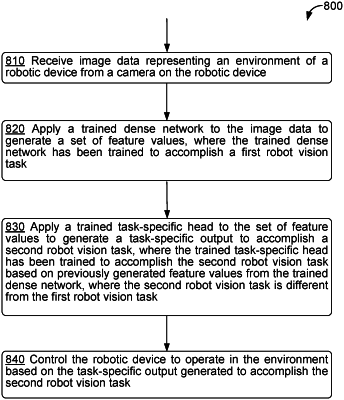| CPC B25J 5/007 (2013.01) [G06F 18/214 (2023.01); G06V 10/40 (2022.01); G06V 10/454 (2022.01); G06V 10/764 (2022.01); G06V 10/776 (2022.01); G06V 10/82 (2022.01); G06V 10/95 (2022.01); G06V 10/955 (2022.01); G06V 20/10 (2022.01); G06V 20/64 (2022.01)] | 20 Claims |

|
1. A method comprising:
receiving a trained dense network and a first trained task-specific head, wherein the trained dense network has been trained to generate feature values based on image data, and wherein the trained dense network and a first trained task-specific head have been trained to accomplish a first robot vision task;
receiving first image data representing an environment of a robotic device from a camera on the robotic device;
training a second task-specific head based on the first image data to generate a task-specific output to accomplish a second robot vision task, wherein the second task-specific head is trained to accomplish the second robot vision task based on feature values generated by the trained dense network, wherein the second trained task-specific head is trained to accomplish the second robot vision task after the trained dense network and the first trained task-specific head were trained to accomplish the first robot vision task, wherein each of the first robot vision task and the second robot vision task involves processing image data to acquire specific information needed to accomplish a different corresponding robot task, wherein each robot task involves a different type of physical manipulation of the environment by the robotic device; and
outputting the trained second task-specific head.
|